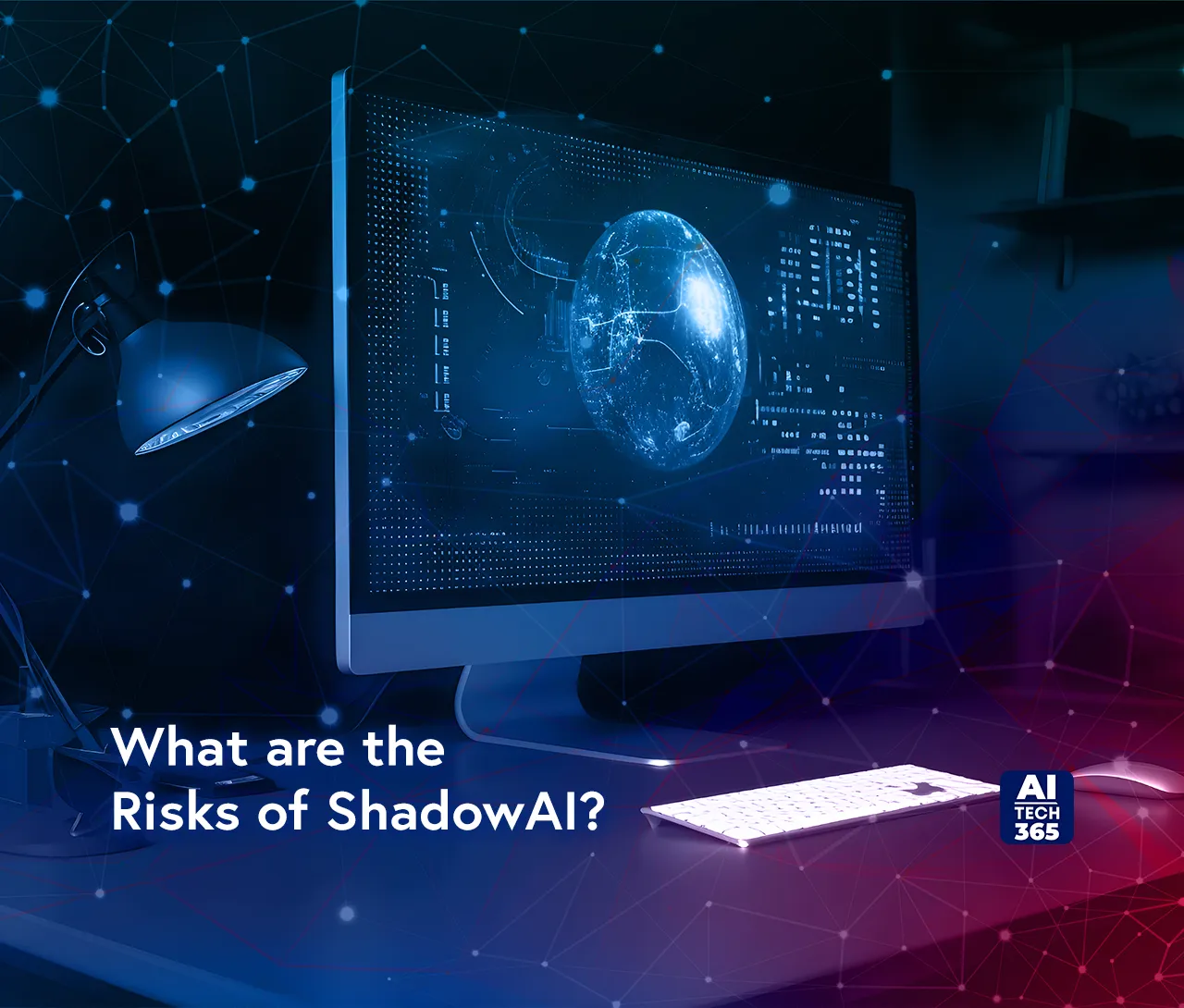Generative AI has become the apple of the eye for users across the globe. Its popularity and surge in adoption globally are quite revolutionary and alarming at the same time. A report by Gartner predicts that by 2025, nearly 75% of the resources will use AI to enhance efficiency without IT oversight. This unauthorized use of AI tools and technologies, referred to as shadow AI, can expose enterprises to significant risks.
In this blog, we will have a look at the definition of shadow AI, its risks, examples, and ways to detect it.
What is Shadow AI?
The utilization of AI applications and tools without obtaining consent or explicit authorization from an organization’s IT department is referred to as shadow AI. Shadow AI in enterprises is becoming a more common sight these days. The workforce updates all the latest deployed AI functionality of the current and already approved tools. However, they do not realize that the upgrade needs to be reviewed by the security and IT team before deploying them on the enterprise tech stack.
Teams or business units driven by agility and innovation utilize SaaS AI applications to increase productivity and achieve their goals. These teams might not wait for proper approval or review from the centralized IT and cybersecurity teams.
What are the Risks of ShadowAI?
 Even if your workforce thinks that AI tools and technologies can be harmless, they pose significant threats to the organization. Data security breaches and compliance hurdles are some of the significant risks of shadow AI. Following are a few risks that are inherent to shadow AI:
Even if your workforce thinks that AI tools and technologies can be harmless, they pose significant threats to the organization. Data security breaches and compliance hurdles are some of the significant risks of shadow AI. Following are a few risks that are inherent to shadow AI:
● Consumer Privacy Concerns
Shadow AI risks go beyond internal operations and might have concerns related to maintaining consumer privacy. Enterprises should consider the consequences of exposing client data or sensitive intellectual property information to unauthorized AI applications.
● Zero Knowledge of Mitigation
One of the key threats is rooted in the opaque use of shadow AI. Most businesses usually are unaware of how these tools are being used. Hence, decision-makers are not able to evaluate the risks associated with these tools and deploy efficient strategies to mitigate the risks. Various work resources might engage in shadow IT practices. This trend is expected to grow in the future. The lack of transparency in the utilization of AI exposes businesses to unexpected risks.
● Prompt Injection Attacks Risks
AI tools developed on large language models (LLMs) are vulnerable to prompt injection attacks. During such attacks, malicious actors make these models act unexpectedly. This becomes a significant risk to the business as AI solutions get autonomous in the IT ecosystems. For example, an AI email application can unintentionally reveal sensitive data or allow account takeovers. It will result in compromising critical assets and operating systems of the organization.
● Unintentional Exposure of Sensitive Data
While using generative AI tools such as Googe Bard or ChatGPT, employees might unintentionally feed sensitive data to these tools. Another report by Cyberhaven titled “The Cubicle Culprits” suggests that generative AI tools account for 13.1% of data exfiltration vectors. When organizations do not properly vet and approve the use of data, there’s no assurance that the information will eventually be utilized. Unsecured AI models might use organizations’ sensitive data to train their AI models. It can also possibly lead to being a victim of a cyberattack, which can result in data leaks.
● Discrepancy in Privacy Policy
Every tool has its unique data retention and privacy policies. Not many workers read these policies thoroughly before utilizing them. Things will be even worse when the tools decide to upgrade their policies. Letting users navigate these challenges by themselves can result in compliance adherence hurdles in the future.
Also Read: The Ultimate Beginner’s Guide to Machine Learning in Cybersecurity
What are the Examples of ShadowAI in Enterprises?
 Here are some real-world examples of Shadow AI in action:
Here are some real-world examples of Shadow AI in action:
1. Self-approved AI Adoption
Sometimes, entire teams or departments start using AI to streamline tasks or run analyses without the IT team’s knowledge. When this happens, they often skip important security checks and governance reviews, which can leave the organization exposed to potential risks.
2. Unexamined AI Code
Developers may use AI-generated code to speed up their projects. But if they don’t thoroughly review and test the code, it can introduce security vulnerabilities, opening the door to future issues.
3. AI in Pre-sales
Marketing teams are adopting AI tools to quickly churn out blog posts, social media content, or ad copy. Without proper oversight, this can result in subpar content that doesn’t align with the brand’s standards or voice. This can ultimately damage the brand’s reputation.
4. Unauthorized AI Usage
Employees might utilize tools like ChatGPT or DALL-E to write emails, draft reports, or create images without getting consent from the company. This can put sensitive data at risk, especially if private or confidential information is entered into these platforms.
The core problem with Shadow AI is that it operates outside the organization’s radar. Without visibility, governance, or a proper risk assessment, this unchecked AI usage can lead to security breaches, compliance issues, and operational headaches that the organization may not be equipped to handle.
Managing ShadowAI in Business
To manage shadow AI in businesses needs a holistic approach of transparent communication and technical monitoring. For the workforce, business leaders should consider having clear conversations across the enterprise to facilitate transparency. It is an effective way for organizations to explain to their team the risks exposed by unauthorized AI adoption. Executing regular surveys and interviews provides insights into the usage of unauthorized AI tools across different departments. This approach allows business leaders to make strategic decisions while facilitating a culture of accountability.
There are various shadow AI detection tools that allow businesses to detect the use of unauthorized AI applications and mitigate the risks associated with it. Additionally, there are tools available that help businesses detect shadow IT and shadow AI in a single pane of glass. Cybersecurity tools such as cutting-edge firewalls and internet gateways allow teams to manually detect potential shadow AI occurrences. CloudEagle and Harmonic Security are at the forefront of offering shadow IT and shadow AI tools. It is crucial to have a strategic dual technique that encompasses shadow AI detection tools and employee awareness.
Encouraging open conversations and educating employees about the risks of unapproved AI use helps build a culture of trust rather than blame. When employees feel safe to self-report, it fosters collaboration and accountability across the organization. At the same time, implementing a variety of monitoring tools ensures that any unauthorized AI activities are quickly detected and addressed before they escalate into bigger issues.
This balanced approach allows organizations to tap into the incredible potential of AI while protecting their data, operations, and reputation from the risks that come with unchecked AI usage. By promoting awareness and maintaining oversight, businesses can confidently embrace AI innovations without compromising security or governance.
The Importance of Managing ShadowAI in Business Ecosystems
Shadow AI poses serious challenges to organizations, such as data privacy violations, compliance breaches, and operational inefficiencies. However, by recognizing these risks and acting proactively, businesses can detect and reduce the dangers associated with unsanctioned AI use.
To manage these threats, companies should assess how AI tools are being used across the organization, strengthen monitoring and security systems, and foster a culture that emphasizes compliance and responsibility. This approach ensures that AI can be leveraged safely, protecting both the organization and its assets.


